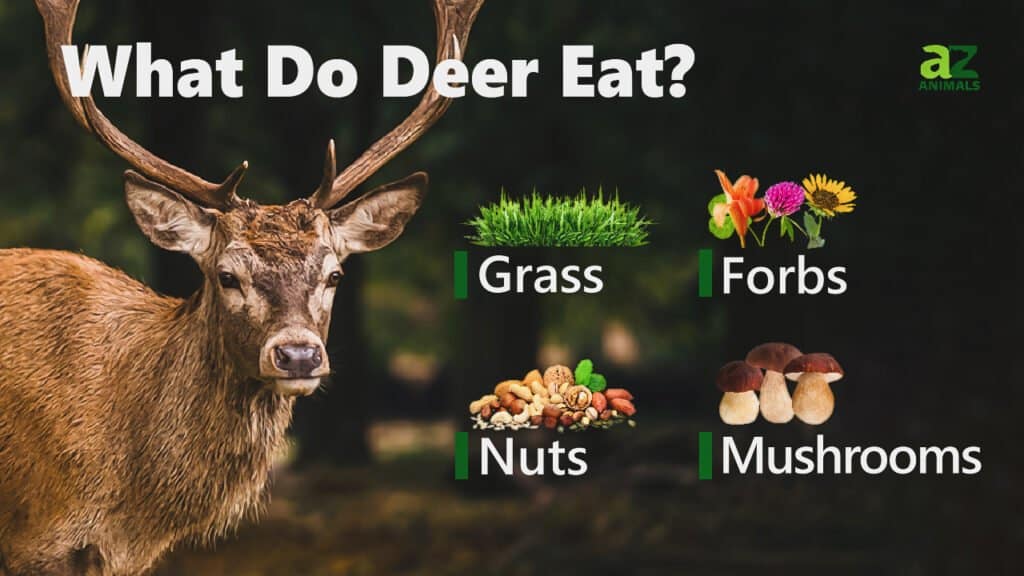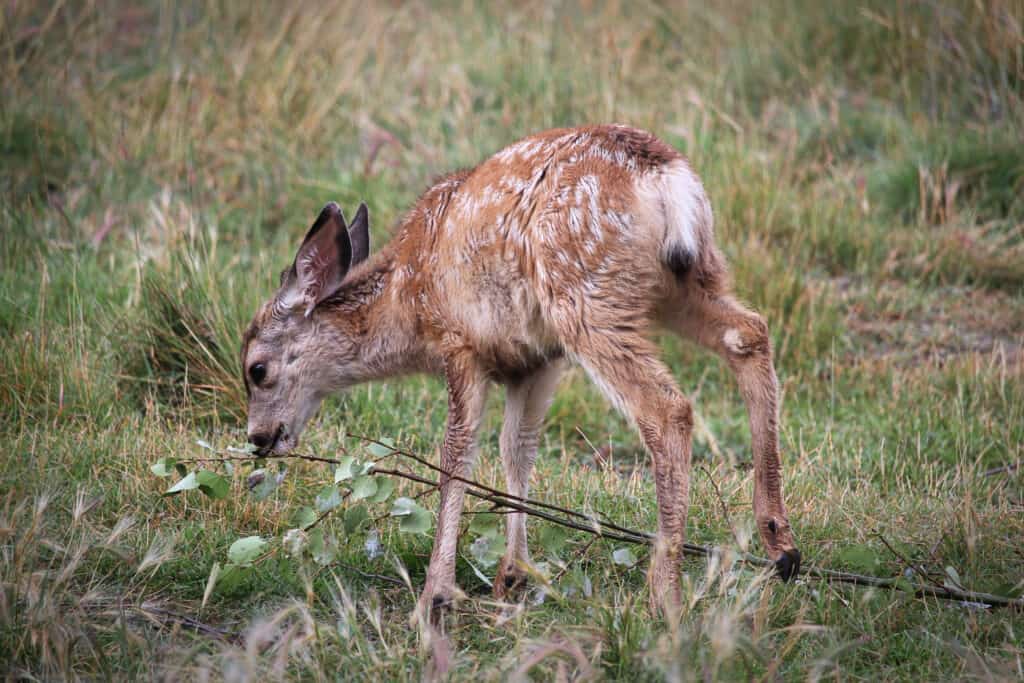Many deer species are known to visit towns and be around humans. But is this part of their natural behavior? They probably leave their natural habitats to look for food, especially during winter. However, feeding deer isn’t recommended because it may disturb their natural life cycle and may even pose a risk to their population.
Sustaining their wild habitats is the best we can do to help these adorable creatures. So what do they eat in the wild? When do they prefer to forage for food? And how do they survive the cold season? Let’s find out!
What Are Deer?

Deer can survive in various habitats, from tundras to tropical rainforests.
©miroslav chytil/Shutterstock.com
Deer are hoofed mammals in the Cervidae family. There are two deer groups:
- The Cervinae group includes the elk, the muntjac, the fallow deer, and the red deer;
- The Capreolinae includes the white-tailed deer, the reindeer, the moose, and the roe deer.
Deer can survive in various habitats, from tundras to tropical rainforests. Most of them prefer temperate mixed deciduous forests, tropical seasonal or dry forests, mountain mixed coniferous forests, and savannas.
Deer can be found worldwide, although Antarctica and Australia have no indigenous representatives. North America’s largest deer population is in the Canadian Rocky Mountain and Columbia Mountain regions and consists of five North American species: caribou, elk, mule deer, moose, and white-tailed deer.
Deer size varies depending on the species, but most males are larger than females. One of the most distinguishable deer features is their antlers. Moreover, they have a tail, long ears, and long, powerful legs.
The moose is the largest extant deer. It can grow up to 8 ft 6 in tall and weigh up to 1,800 pounds. On the other hand, the smallest deer species is the northern pudu, measuring up to 14 inches at the shoulders and weighing up to approximately 13 pounds.
Most deer have a reddish or brownish color, while some can have a grayish shade. However, there are albino, melanistic, and piebald deer, which have unique coat patterns. Albino deer are completely white and have pink eyes. Melanistic deer have a dark, almost black coat, while piebald deer have a brown coat with white spots.
What Do Deer Eat?

Deer are herbivorous animals. They eat sedges, nuts, grasses, shrubs, forbs, trees, and lichens. Since they have small stomachs but high nutrition requirements, deer do not have the same eating habits as sheep do, for example. They do not prefer eating lots of low-grade fibrous food. Instead, they are selective eaters, choosing easy-to-digest foods.
Hence, they go for shoots, leaves, and grasses that pass rapidly through their digestive system. They can also eat soft twigs, fungi, and fruit. A healthy adult deer can consume up to 2,000 pounds of vegetables annually!
Moreover, because they grow antlers, their diet must be rich in calcium and phosphate to support the growth.
Some deer have been spotted exhibiting carnivorous behavior, as they fed on dead alewives (an anadromous herring species living in North America) or plundered northern bobwhites nests. White-tailed deer, for example, have been seen eating field mice, songbirds, or birds trapped in mist nets.
A deer’s diet highly depends on the weather. While they won’t have a specific diet and will eat whatever they can find during spring or summer, during autumn, they’ll forage for foods that will help them survive the cold season when there’s little to no food available. For example, deer will feed on nuts with high nutritional values during fall.
A List of Foods Deer Eat
Here’s a list of foods deer eat:
- Grasses
- Shrubs
- Crops
- Forbes
- Leaves
- Shoots
- Soft twigs
- Fungi
- Fruit
- Nuts
- Forbs
- Acorns
- Pecans
- Staghorn sumac
- Alfalfa
When Do Deer Eat?

Deer are most active at dawn and dusk.
©Ginger Livingston Sanders/Shutterstock.com
While deer can eat anytime, they prefer going out at night because they are less visible to predators. They are considered crepuscular animals, meaning they’re most active at dawn and dusk thanks to their keen eyesight.
Moreover, deer are more active during fall when they prepare for winter. Since there isn’t much food for them during winter, they increase their food intake during fall to provide the body with the necessary nutrients. Their primary food sources at this time are nuts and acorns, which have high nutritional value and help them gain enough fat to survive the winter. That’s when they’re most active during the day.
Once spring settles in, deer return to their crepuscular lifestyle.
Should You Feed Deer?
Stumbling upon a deer may seem like an invitation to feed them. But is it a good idea? Not really. Feeding deer isn’t recommended and is even illegal in some parts of the world. Why?
Because deer will get used to people feeding them and depend less on their wild habitat and more on humans; moreover, they’ll likely gather in larger groups. In this case, if one deer gets sick, the disease will spread to all the others.
Since they’ll return to towns looking for food, they may be attacked by domestic dogs and coyotes or hit or killed by cars. This may also reduce their fat reserves as they’ll use their energy to get to the city.
Do Deer Negatively Impact Ecosystems?

Deer can negatively impact woodland ecosystems because of their feeding habits.
©iStock.com/:Akchamczuk
Unfortunately, deer can negatively impact woodland ecosystems because their feeding habits may prevent natural woodland regeneration.
For example, suppose new woodlands are being created either through natural processes or by planting. In this case, deer can rapidly colonize the area and prevent the trees from growing as intended by greatly impacting young seedlings. It is believed that 20 deer per square mile can rapidly destroy the forest environment!
On the other hand, deer can also help maintain their habitats clean if they forage in open environments.
Deer Predators
Deer have many predators in the wild, including cougars, wolves, jaguars, alligators, bobcats, bears, wolverines, and coyotes. Even dogs can attack smaller deer species. Fawns are susceptible to golden and bald eagle predation, and sometimes even American crows and common ravens.
Albino (white) and piebald (brown with white spots) deer are at a higher risk of being killed by predators because they can be easily spotted.
Up Next:
- What Do Deer Eat?
- How and Where Do Deer Sleep? Patterns and Habitats
- Deer Hooves: Everything You Want to Know About Deer “Feet”
The photo featured at the top of this post is © Ginger Livingston Sanders/Shutterstock.com
Sources
- University of Minnesota Extension, Available here: https://extension.umn.edu/my-minnesota-woods/how-identify-deer-browse-woods#
- University of New Hampshire Extension, Available here: https://extension.unh.edu/resource/more-harm-good-why-you-shouldnt-feed-deer
- Woodland Trust, Available here: https://www.woodlandtrust.org.uk/blog/2019/05/what-deer-eat/
- American Tarantula & Animals, Available here: https://www.atshq.org/what-does-deer-eat/
Thank you for reading! Have some feedback for us? Contact the AZ Animals editorial team.







